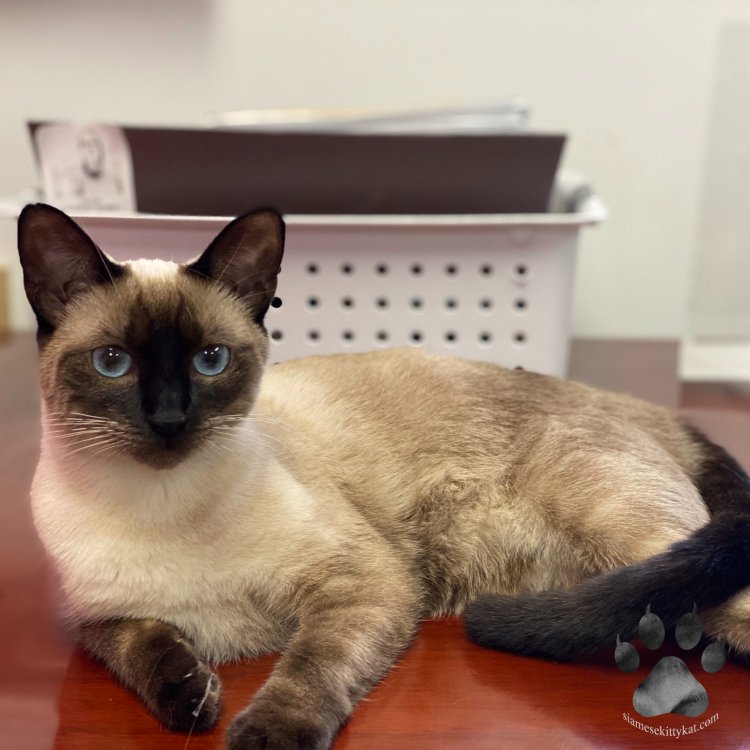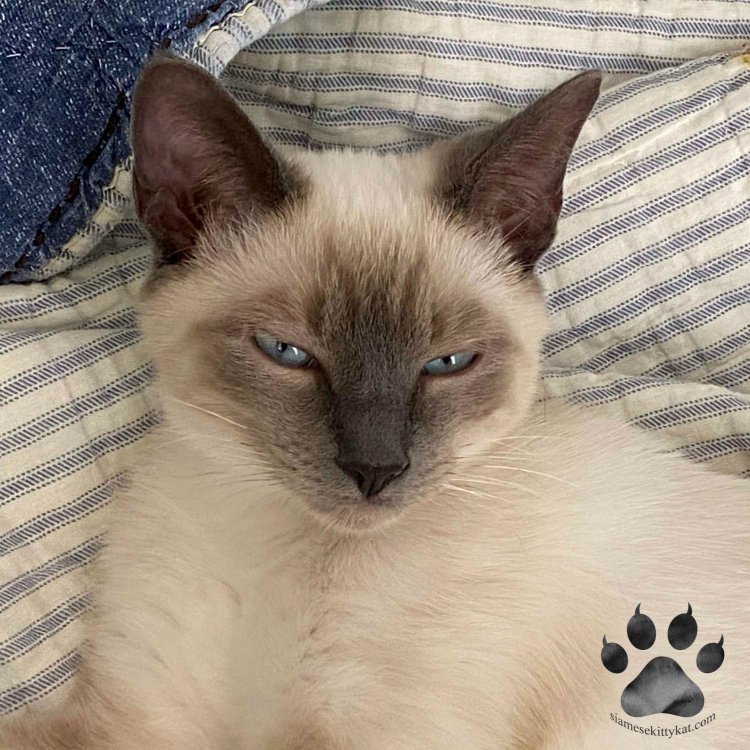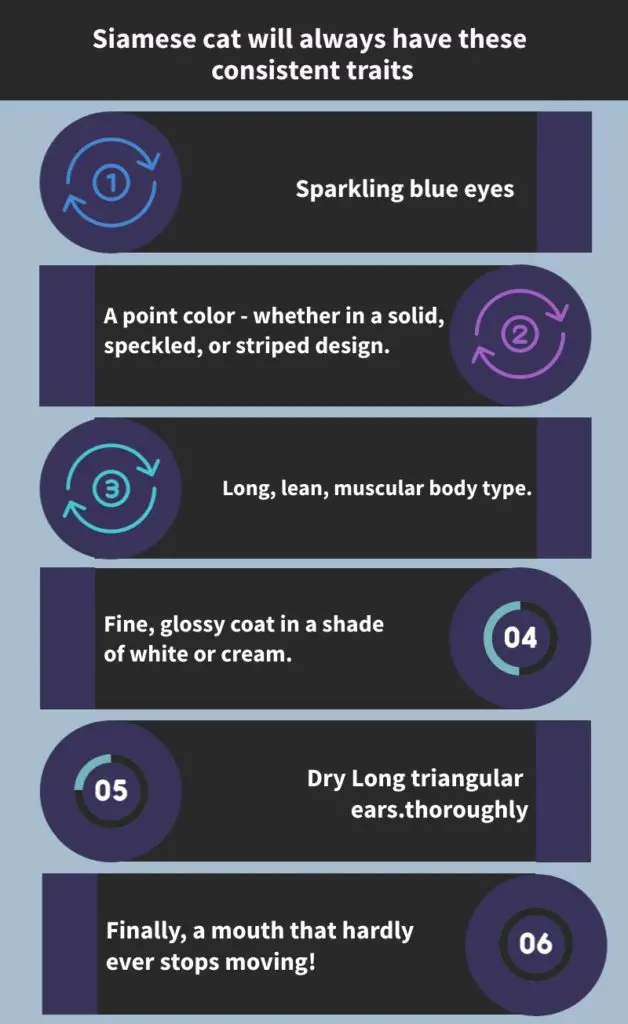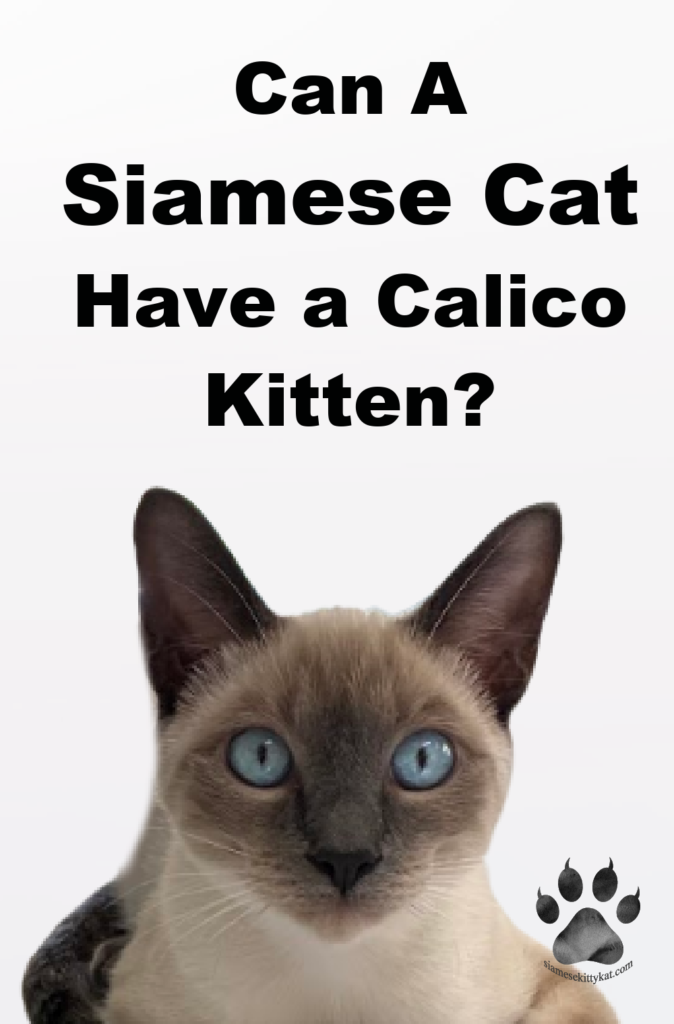A male Siamese cat can have a calico kitten. He can sire one that is. But the kitten will be 50 percent calico, and then only if she identifies as a color. But it is very unlikely that a Siamese cat can give birth to a calico kitten. This is because the majority of male calico cats are sterile.
Why can’t a Siamese cat have a calico kitten?
A Siamese cat can’t have a calico kitten because of the lack of male calicos. But first let’s dispense with the notion that “calico” is a breed. A calico cat can be any domestic breed with a tri-colored coat. The coat is usually 75 percent white with large black and vibrant orange patches.
By formally accepted standards, there are 12 breeds that can carry the calico coat. The most popular are:
More unexpected occurrences include the Turkish Van (usually white), and the Arabian Mau. This guy is generally tabby-striped. Tabby is also a pattern, as opposed to a breed.
Now the genetics study. While it is possible for a female Siamese cat to give birth to a calico-patterned kitten, it is unlikely. In fact, it would be like winning the lottery. There are two chips that would have to fall in your direction:
1.) Fewer than 1 in 1000 calico cats are male. This is because the X chromosome generates both the colors orange and black. In males, the color orange is usually expressed as a striped pattern. Hence the tabby Tom! For a male to sport the calico coat, he would have to carry two X chromosomes, and a Y. This is rare.
2.) Don’t get too excited, breeders. Even if one of these rare births does occur, a calico-patterned Siamese is still unlikely. Because your male calico has two of the female X chromosomes, he isn’t likely to grow up to be a daddy. This cause of infertility isn’t singular to felines. When it occurs in humans, it’s called Klinefelter syndrome.
Can a calico cat have a Siamese kitten?

Yes! The male Siamese has no such fertility issues. It is very easy for this stallion to rope himself a calico gal and produce partial Siamese offspring. And his heritage will live on especially in his sons. Because remember that male calicos are rare.
But this poor fellow isn’t likely to gain admittance to the Siamese country club. This is because most pointed breeds don’t accept calico halfies as members. And the Siamese Sands is especially particular. This kitten won’t gain entrance because he will only be half Siamese, and half the mother’s breed. And she could be any one of the 12 breeds that display the calico pattern.
Looking for a Siamese kitten to adopt? Click the link to the article on my site to know where you can find one for free. I also discussed what is involved in the shelter adoption process and everything else that you need to know about adopting a Siamese cat.
What is the personality of calico Siamese cat?
Though not a breed, there are certain personality traits attributed to the calico. Like how a person with red hair might have a fiery personality. Calico cats are sweet, warm-hearted, and intelligent. They enjoy spending time with both you and your children or grandchildren.
The Siamese, of course, is loyal, loving, and intelligent. She also dotes on the younger generation – as long as it dotes on her! And both cats are playful, so you get 100 percent of the fun. They will absolutely enjoy an interactive toy like the YVE LIFE Cat Laser Toy which you can buy from Amazon.
No wonder there is so much demand for a calico-Siamese mix. You get half the genetic traits of the Siamese, with the calico’s positive personality. You end up with an intelligent, loving cat with a pleasing pattern.
But aren’t calico cats supposed to be strong-willed and feisty? You’re thinking of the Tortoiseshell. Again, “tortoiseshell” is a pattern, not a breed. They are also called “torties” or “dilute torties”.
The tortie is less likely to have white as her dominant color. She is most often a colorful combination of orange and black. You can also go ahead and sprinkle in patches of red, amber, ginger, and cinnamon. That’s exactly how some torties appear – kind of like God decided to add some sprinkles for fun! The patches can also look like mottling, or like part of a quilt pattern.
Despite their unfortunate reputation, torties can be loyal, loving pets.
Can a Siamese cat be a tabby pattern?

Meet the Tabby Pointed Siamese. He’s so pleased to meet you, he’s all tied up in stripes! Also called the Lynx Point Siamese, you may have read about him here a couple of weeks ago. So I won’t go into great detail.
I’ll only say that he is the product of a mating between the Seal Point Siamese and a Tabby. He sports stripes on the usual pointed areas – the legs, tail, cheeks, and eyes. He will not have stripes actually on his ears. At least I’ve never seen it, but please let me know if you do!
The Tortie-Point Siamese is the offspring of a Siamese father and a tortie mother. While the reverse can be true, most torties are female due to the stronger expression of the X chromosome.
How about black cats? Can a black cat be part Siamese? Yes, it’s actually possible! This occurs when a purebred Siamese cat mates with a cat with zero percent Siamese genetics. Explore more about this topic by simply clicking on the link to the article.
What point colors can a Siamese cat be?
The four main Siamese point colors are seal point, chocolate point, blue point, and lilac point.
| Main Point Colors of Siamese Cats | Body Color | Color Progression As They Age | Point Color |
|---|---|---|---|
| Seal Point | ranges from fawn to cream, with lighter shades on the chest and belly part | the color of their backs may turn beige or dark brown during their later years | face, ears, tail, legs and paw colors range from dark brown to black, |
| Chocolate Point | ranges from cream to ivory | darkening may happen on their later years as opposed to Seal Points | brown in color but lighter than Seal Points |
| Blue Point | bluish white | A blue point’s color always darkens as they age | gray or silvery-blue |
| Lilac Point | cream, beige or white | zero to minimal color progression as they get older | light gray or brown with pink paw pads |
Here are four lesser known point colors:
Red Point: This kitten took a lot of effort to get right. Breeders started with a Siamese, then managed to locate a red tabby-tortoiseshell mix. She has red-gold points in the usual places. Her body is a warm white with sweet pink paw pads and nose.
Cinnamon Point: The perfect focus cat for fall. These guys have cinnamon and brown points displayed on an ivory body. Their defining feature is the cinnamon color around their eyes and on their paw pads.
Cream Point: A Siamese, a red domestic short-hair, and an Abys go on a date. Three months later, the cream point Siamese appears. She’ll have a warm cream colored coat with cooler cream points. She is among the most delicate of the breed.
Apricot Point: Another cat with a flare for fall. He’s creamy white with hot cream colors shading in. These points take on a bit of a different flare. They appear speckled or striped on his arms and tail.

This concludes your feline genetics lesson for today. Please come back next week to find out why Siamese cats have crooked tails. I can’t wait to explore this one with you!
What color kittens can a calico have?
Calicoes are, without a doubt, the world’s most colorful kitties. They’re one of the only cats to flaunt such a colorful coat, with a wide range of variety and patterns.
Since they’re technically not a breed and these color variations are simply genetic, they can occur in any size, shape, or form.
There are 3 different types of calico kitties, the most common being the tri-color pattern, which features white, black, and orange colors. Although it is normal for some calicoes to have shades of brown, red, cream, and blue-black.
Because these colors can occur across so many different breeds, it can sometimes be difficult to tell if your feline is a calico or a tortoiseshell.
The best way to differentiate the two is to take a look at their patterns. A tortie will have their primary colors mixed within their coat, while a calico will have clear patches of color.
Let’s take a look at the 3 different types of calico kitties:
Traditional Calicos
The Traditional Calico features 3 different colors: orange, black and white. They look super similar to Tortoiseshell kitties, therefore they are often referred to as Tortie-and-White cats.
Their face, chest, and legs are typically white and they have orange or back ears, foreheads, and backs. They may have one color more present than another, but they have to have a mix of the two colors to be considered a traditional calico.
Dilute Calicos
These calicos are very much like their traditional calico brothers and sisters, the only difference being their colors appear more diluted.
Instead of the blacks and oranges, their colors will appear a smokey blue and cream or tan colored. Some countries refer to dilute calicos as ‘clouded tigers.’
Both parents must possess this particular recessive gene to get a dilute calico kitten, yet can’t be a dilute calico themselves.
Patched Tabby
Calico felines can also look very similar to tabby cats. You’ll be able to tell they’re a patched tabby if they have an M-shaped mark on their foreheads. They are sometimes referred to as ‘calibby.’
This particular shade of calico features brown and black patches on their tails, sides, backs, and legs. These kitties typically have white paws and can be either short-haired or long-haired.
Calico kitties can also have long and short hair.
What breed is a calico cat?
Since “calico” only refers to the color pattern and not the breed, determining what your kitty is really has nothing to do with their calico coats.
You’ll have a lot more luck finding out their breed by analyzing their other traits such as eyes, ears, and tail, etc. It is also possible to have your cats DNA tested if you’re really interested in finding out what they are.
To help narrow it down for you, here are some of the cats that can possibly have the calico gene:
What makes a cat a Siamese?
Since we’ve already covered what color points your Siamese may be, let’s check out the other distinctive traits, both physical and personality-wise, that make your kitty the beautiful Siamese it is.
There are actually 4 different types of Siamese kitties, all with their unique yet distinctive traits.
Classic Siamese
These are the Siamese kitties you’ll more than likely find in most homes in and around America.
The classic version of this breed appears the most athletic, sporting a long, sleek body with a long tail. Their ears will be slightly bigger than the traditional Siamese, and their face will be pointy with a slightly upturned nose.
The classic Siamese is much more energetic than the traditional Siamese but just as loving and affectionate. In fact, they can be a little pushier when it comes to getting the attention they crave.
Traditional Siamese
The traditional Siamese, also known as the Applehead Siamese, is much stockier than the Classic Siamese. Their head resembles an apple (hence the name) and their nose points down instead of upturned.
They have a larger frame, and their ears are a lot smaller than the Classic Siamese. They’re typically taller too.
Traditional Siamese kitties are incredibly friendly and adore people. Cuddling is their middle name, and they want nothing more than to cuddle up on your lap.
Much like all of the versions of Siamese felines, Applehead Siamese is very vocal. If they want something, you’ll know about it! The Applehead also tends to over-groom, especially when stressed.
Old Style Siamese
This version of the Siamese is of medium size and has a lankier body than the Applehead. Their ears resemble more of the Classic Siamese as opposed to the Traditional Applehead.
If you’re having trouble telling the Old-Style Siamese and the Classic Siamese apart, these kitties have a nose that points straight ahead, and their face is slightly shorter.
Personality-wise, they’ll stick to their owner like glue. They will follow you around the house every opportunity they get and your business is their business. They may not be as vocal as the Applehead, but they sure have some pipes on them.
Wedgehead Siamese
The Modern Wedgehead looks the most different between the 4 variations of Siamese kitties. They rose to popularity in the 1980s due to their narrow, wedge-like heads.
They have very pointy ears, sitting lower on their heads compared to the Classic Siamese. They have a long, lean, and athletic body shape. Their eyes are slanted and they have wider noses that point out straight.
This version of the Siamese is the one you’ll usually find at shows. They are just as loving as their Siamese brothers and sisters.
The downside to cross-breeding this version, however, means a large portion of them are prone to kidney disease.
How can I tell if my kitten is part Siamese?
Since Siamese cats have striking appearances, you may think their traits will be impossible to miss. However, identifying whether or not your kitty is part Siamese may be harder than you think!
Generally, Siamese cats can be identified by their bright blue eyes, pointed head, and unique fur patterns and colors. Some Siamese kitties have large, pointy ears, while others have a wedge-like head shape.
Since there are 4 different types of Siamese kitties, it can be tough to tell if your feline is part Siamese. It’s a pretty thorough process and you’ll have to analyze not only how they look, but how they act too.
Let’s take a look at a few of the things that can help identify a Siamese kitty.
The Bottom Line
Siamese cats are a marvelous breed, to say the least. Their unique genetics set them aside from your usual moggie, leaving them with special colorings and features.
Due to their genetic makeup, it’s impossible for a purebred Siamese to be a calico. However, nothing is stopping a male Siamese from breeding with a female calico, producing a half Siamese and half calico offspring. However, the Siamese genes are more dominant than most.
There are many colors, shapes, and sizes of Siamese kitties – yet all are loveable and adore their owners more than anything!
Be the Siamese Cat expert you always wish to be! From color points to similar cat breeds, discover everything you need to know about their unique charm and characteristics in our comprehensive guide: Siamese Cat Breed: Types, Color Points and Comparison to Other Cat Breeds
Get your FREE Siamese Cat 2025 Printable Calendar

